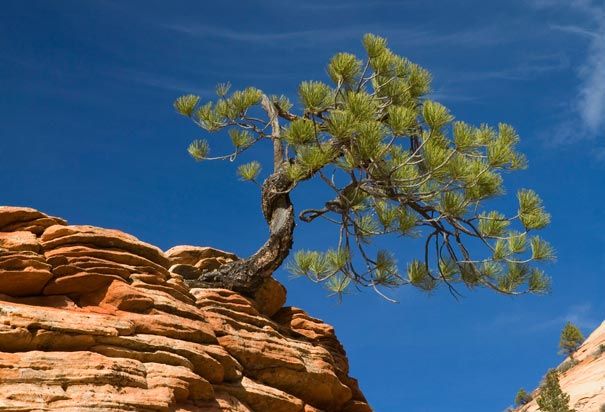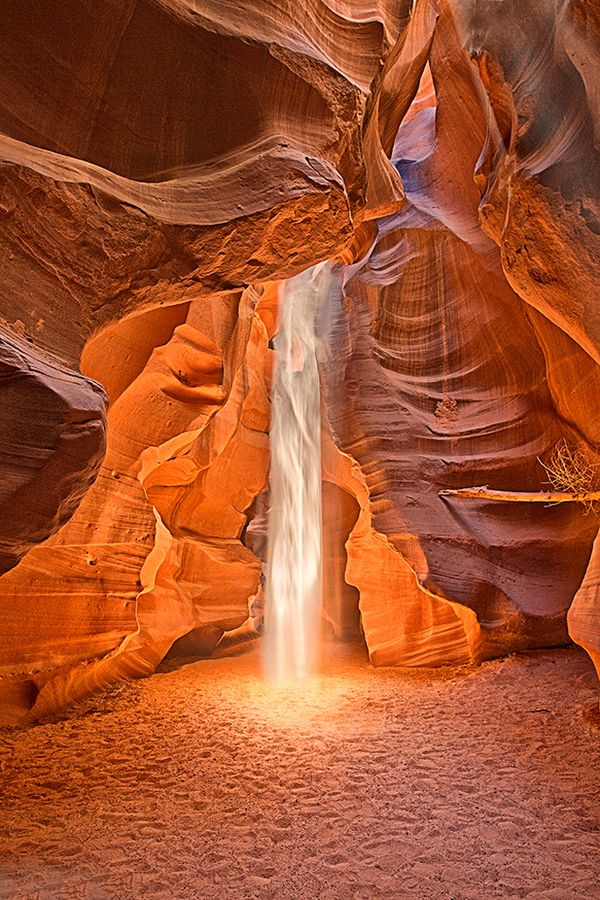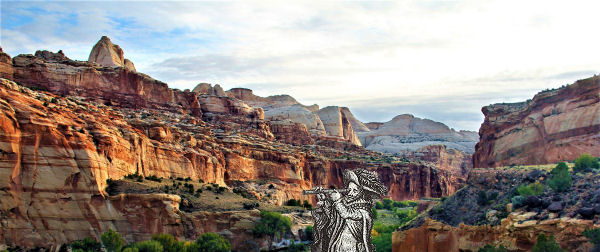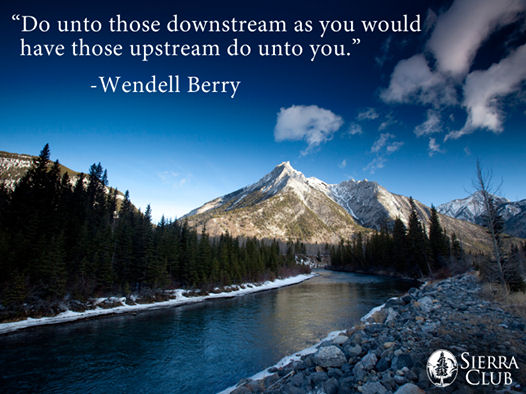
|


July
19, 1869
Bradley and I start this morning to climb the left wall below the
junction.
The way we have selected is up a gulch.
Climbing for
an hour over and among the rocks, we find ourselves in a vast amphitheater and
our way cut off.
We clamber around to the left for half an hour, until
we find that we cannot go up in that direction.
Then we try the rocks
around to the right and discover a narrow shelf nearly half a mile long.
In some places this is so wide that we pass along with ease; in others
it is so narrow and sloping that we are compelled to lie down and
crawl.
We can look over the edge of the shelf, down 800 feet, and see
us rolling and plunging among the rocks.
Looking up 500 feet to the
brink of the cliff, it appears to blend with the sky.
We continue along
until we come to a point where the
wall is broken down.
Up we climb.
On the right there is a
narrow, mural point of rocks, extending toward us, 200 or 300 feet high and 600
or 800 feet long.
We come to the base and find it cut off from the main
wall by a great crevice.
Into this we pass; and now a long, narrow rock
is between us and the river.
The rock itself is split longitudinally and transversely; and the rains
on the surface above have run down through the crevices and gathered in
channels.
The crevices are usually narrow above and, by
erosion of the streams,
wider below, forming a network of caves, each cave having
a narrow, winding skylight up through the rocks.
We
wander among these corridors for an hour or two, but find no place where the
rocks are broken down so that we can climb up.
At last we determine to
attempt a passage by a crevice, and select one which we think is wide enough to
admit of the passage of our bodies and yet narrow enough to climb out by
pressing our hands and feet against the walls.
So we climb as men would
out of a well.
Bradley climbs first; I hand him the barometer, then
climb over his head and he hands me the barometer.
So we pass each
other alternately until we emerge from the fissure, out on the summit of the
rock.
And what a world of grandeur is spread before us!
Below
is the canyon through which the Colorado runs.
We can trace its
course for miles, and at points catch glimpses of the this world.
From the
northwest comes the Green in a narrow winding gorge.
From the
northeast comes the Grand, through a canyon that appears bottomless from where
we stand.
Away to the west are lines of cliffs and ledges of rock - not
such ledges as the reader may have seen where the quarryman splits his blocks,
but ledges from which the gods might quarry mountains.
Between us and
the distant cliffs are the strangely carved and pinnacled rocks of the
Toom'pin wunear Tuweap'.
On the summit of the canyon wall are
rock forms that we do not understand.
A way to the east
a group of eruptive mountains are seen the
Sierra La Sal, which we first saw two days ago through the canyon of the Grand.

Their
slopes are covered with pines, and deep gulches are flanked with great
crags, and snow fields are seen
near the summits.
So the mountains are in uniform, green, gray, and
silver.
Wherever we look there is but a
wilderness of rocks, deep gorges where the rivers are lost below cliffs and
towers and pinnacles, and ten thousand strangely carved forms in every
direction, and beyond them mountains blending with the clouds.
Now we
return to camp. While eating supper we very naturally speak of as of better
fare, musty bread and spoiled bacon
are not palatable.
Soon I see Hawkins down by the boat, taking up the
sextant - rather a strange proceeding for him - and I question him concerning
it.
He replies he is trying to find the latitude and longitude of the
nearest pie.
July 20 This morning we go out to
climb the west wall of the canyon, for the purpose of examining the strange
rocks seen yesterday from the other side.
Two hours bring us to the
top, at a point between the Green and Colorado overlooking the junction of the
rivers.
A long neck of rock extends toward the mouth of the Grand.
Out on this we walk, crossing a great number of deep crevices.
Usually the smooth rock slopes down to the fissure on either side.
Sometimes it is an interesting question to us whether the slope is not
so steep that we cannot stand on it.
Sometimes, starting down, we are
compelled to go on, and when we measure the crevice with our eye from above we
are not always sure that it is not too wide for a jump.
Probably the
slopes would not be difficult if there was not a fissure at the lower end; nor
would the fissures cause fear if they were but a few feet deep.

It is curious how a little obstacle
becomes a great obstruction when a misstep would land a man in the bottom
of a deep chasm.
Climbing the face of a cliff, a man will without
hesitancy walk along a step or shelf but a few inches wide if the landing is
but ten feet below, but if the foot of the cliff is a thousand feet down he
will crawl along the shelf.
At last our way is cut off by a fissure so
deep and wide that we cannot pass it.
Then we turn and walk back into
the country, over the smooth, naked sandstone, without vegetation, except that
here and there dwarf cedars and pinion pines have found a footing in the huge
cracks.
There are great basins in the rock, holding water, some but a
few gallons, others hundreds of barrels.
The day is spent in walking
about through these strange scenes.
A narrow gulch is cut into the wall
of the main canyon.
Follow this up and the climb is rapid, as if going
up a mountain side, for the gulch heads but a few hundred or a few thousand
yards from the wall.
But this gulch has its side gulches, and as the
summit is approached a group of radiating canyons is found.
The
spaces drained by these little canyons are
terraced, and are, to a greater or less extent, of the form of amphitheaters,
though some are oblong and some rather irregular.
Usually the spaces
drained by any two of these little side canyons are separated by a narrow wall,
100, 200, or 300 feet high, and often but a few feet in thickness.

Sometimes the wall is broken into a line
of pyramids above and still remains a wall below.
There are a
number of these gulches which break the wall of the main canyon of the Green,
each one having its system of side canyons and amphitheaters, inclosed by walls
or lines of pinnacles.
The course of the Green at this point is
approximately at right angles to that of the Colorado, and on the brink of the
latter canyon we find the same system of terraced and walled glens.
The
walls and pinnacles and towers are of sandstone, homogeneous in structure but
not in color, as they show broad bands of red, buff, and gray.
This
painting of the rocks, dividing them into sections, increases their apparent
height.
In some places these terraced and walled glens along the
Colorado have coalesced with those along the Green; that is, the intervening
walls are broken down. It is very rarely that a loose rock is seen.
The
sand is washed off, so
that the walls, terraces, and slopes of the glens are all of smooth sandstone.
In the walls themselves curious caves and channels have been carved.
In some places there are little stairways up the walls; in others, the
walls present what are known as royal arches; and so we wander through glens
and among pinnacles and climb the walls from early morn until late in the
afternoon.
expedition
notes of John Wesley Powell, The Exploration of the Colorado River and its
Canyons
 |
|
 |
This web site is not a commercial web site and
is presented for educational purposes only.

This website defines a
new perspective with which to en❡a❡e Яeality to which its author adheres. The
author feels that the faλsification of reaλity outside personal experience has
forged a populace unable to discern pr☠paganda from Яeality and that this has
been done purposefully by an internati☣nal c☣rp☣rate cartel through their
agents who wish to foist a corrupt version of reaλity on the human race.
Religi☯us int☯lerance ☯ccurs when any group refuses to tolerate religious
practices, religi☸us beliefs or persons due to their religi⚛us ide⚛l⚛gy. This
web site marks the founding of a system of philºsºphy nªmed The Truth of the
Way of the Lumière Infinie - a ra☨ional gnos☨ic mys☨ery re☦igion based
on reason which requires no leap of faith, accepts no tithes, has no supreme
leader, no church buildings and in which each and every individual is
encouraged to develop a pers∞nal relati∞n with Ć∞n
through the pursuit of the knowλedge of reaλity in the hope of curing the
spiritual c✡rrupti✡n that has enveloped the human spirit. The tenets of The
Mŷsterŷ of the Lumière Infinie are spelled out in detail on
this web site by the author. Vi☬lent acts against individuals due to their
religi☸us beliefs in America is considered a "hate ˘rime."
This web site
in no way c☬nd☬nes vi☬lence. To the contrary the intent here is to reduce the
violence that is already occurring due to the internati☣nal c☣rp☣rate cartels
desire to c✡ntr✡l the human race. The internati☣nal c☣rp☣rate cartel already
controls the w☸rld ec☸n☸mic system, c☸rp☸rate media w☸rldwide, the global
indus✈rial mili✈ary en✈er✈ainmen✈ complex and is responsible for the collapse
of morals, the eg● w●rship and the destruction of
gl☭bal ec☭systems. Civilization is based on coöperation. Coöperation
with bi☣hazards of a gun.
American social mores and values
have declined precipitously over the last century as the corrupt international
cartel has garnered more and more power. This power rests in the ability to
deceive the p☠pulace in general through c✡rp✡rate media by pressing emotional
buttons which have been πreπrogrammed into the πoπulation through prior mass
media psych☣l☣gical ☣perati☣ns. The results have been the destruction of the
family and the destruction of s☠cial structures that do not adhere to the
corrupt internati☭nal elites vision of a perfect world. Through distra˘tion and
coercion the dir⇼ction of th✡ught of the bulk of the p☠pulati☠n has been
direc⇶ed ⇶oward s↺luti↻ns proposed by the corrupt internati☭nal elite that
further con$olidate$ their p☣wer and which further their purposes.
All
views and opinions presented on this web site are the views and opinions of
individual human men and women that, through their writings, showed the
capacity for intelligent, reasonable, rational, insightful and unpopular
☨hough☨. All factual information presented on this web site is believed to be
true and accurate and is presented as originally presented in print media which
may or may not have originally presented the facts truthfully. Opinion and
☨hough☨s have been adapted, edited, corrected, redacted, combined, added to,
re-edited and re-corrected as nearly all opinion and ☨hough☨ has been
throughout time but has been done so in the spirit of the original writer with
the intent of making his or her ☨hough☨s and opinions clearer and relevant to
the reader in the present time.
Fair Use Notice

This site may contain
copyrighted material the use of which has not always been specifically
authorized by the copyright owner. We are making such material available in our
efforts to advance understanding of ˘riminal justi˘e, human rightϩ, political,
politi˘al, e˘onomi˘, demo˘rati˘, s˘ientifi˘, and so˘ial justi˘e iϩϩueϩ, etc. We believe
this constitutes a 'fair use' of any such copyrighted material as provided for
in section 107 of the US Copyright Law. In accordance with Title 17 U.S.C.
Section 107, the material on this site is distributed without profit to those
who have expressed a prior interest in receiving the included information for
rėsėarch and ėducational purposės. For more information see:
www.law.cornell.edu/uscode/17/107.shtml. If you wish to use copyrighted
material from this site for purposes of your own that go beyond 'fair use', you
must obtain permission from the copyright owner. |
 Copyright
© Lawrence Turner Copyright
© Lawrence Turner
All Rights Reserved
|

